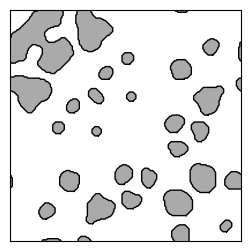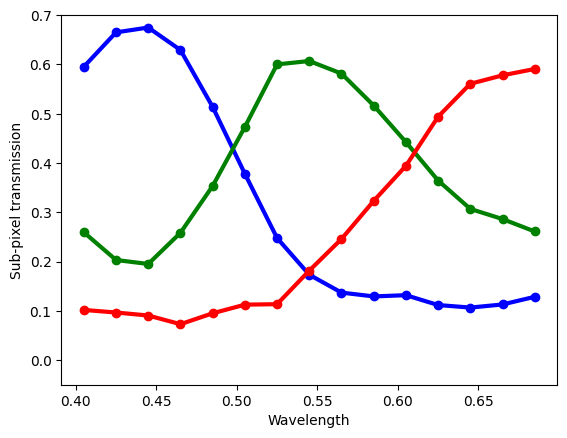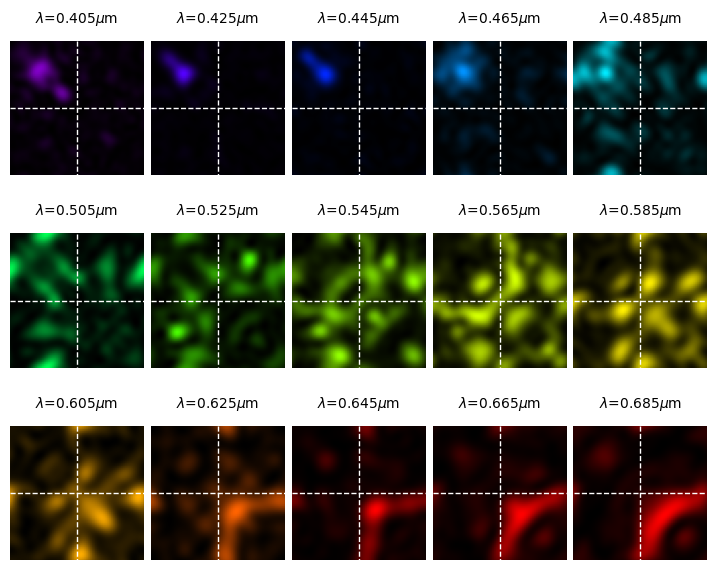Bayer sorter#
The bayer sorter challenge involves the design of a Si3N4 metasurface to split light in a wavelength-dependent way, so that red, green, and blue light is predominantly collected in red, green, and blue subpixels in a sensor array. The challenge is based on Pixel-level Bayer-type colour router based on metasurfaces by Zou et al.
Simulating an existing design#
We’ll begin by loading, visualizing, and simulating a Bayer sorter design from the invrs-gym paper.
import matplotlib.pyplot as plt
import numpy as onp
from skimage import measure
from totypes import json_utils
file = "240325_mfschubert_49ca0bd2450f982c7980208fb1fd88222c3a28694e49d205e51acf107febb17d.json"
with open(f"../../../reference_designs/bayer/{file}", "r") as f:
serialized = f.read()
params = json_utils.pytree_from_json(serialized)
plt.figure(figsize=(3, 3))
ax = plt.subplot(111)
im = plt.imshow(1 - params["density_metasurface"].array, cmap="gray")
im.set_clim([-2, 1])
ax.set_xticks([])
ax.set_yticks([])
for c in measure.find_contours(params["density_metasurface"].array):
plt.plot(c[:, 1], c[:, 0], 'k', lw=1)

Next, create the bayer_sorter challenge, which enables us to simulate and evaluate a bayer sorter design.
The default simulation parameters are chosen to balance accuracy and simulation cost. For this notebook, we’ll override these with settings that yield more accurate results: more terms in the Fourier basis, and more wavelengths.
import dataclasses
import jax.numpy as jnp
from invrs_gym.challenges.bayer import challenge as bayer_challenge
challenge = bayer_challenge.bayer_sorter(
sim_params=dataclasses.replace(
bayer_challenge.BAYER_SIM_PARAMS,
approximate_num_terms=800,
wavelength=jnp.arange(0.405, 0.7, 0.02),
)
)
Now, simulate the bayer sorter.
import jax
response, aux = jax.jit(challenge.component.response)(params)
The response contains the transmission for normally-incident plane wave at the specified wavelengths for both x-polarized and y-polarized fields. The transmission is reported for four sub-pixels; the first is for red, the second and third for green, and the final is for blue.
Plot the transmission into red, green, and blue subpixels
# Average the transmission over the two different incident polarizations.
transmission = onp.mean(response.transmission, axis=-2)
transmission_blue_pixel = transmission[:, 0]
transmission_green_pixel = transmission[:, 1] + transmission[:, 2]
transmission_red_pixel = transmission[:, 3]
plt.plot(response.wavelength, transmission_blue_pixel, "bo-", lw=3)
plt.plot(response.wavelength, transmission_green_pixel, "go-", lw=3)
plt.plot(response.wavelength, transmission_red_pixel, "ro-", lw=3)
plt.xlabel("Wavelength")
plt.ylabel("Sub-pixel transmission")
_ = plt.ylim(-0.05, 0.7)

The transmission is computed by calculating the Poynting flux on the real-space grid at the focal plane, and summing within each sub-pixel quadrant. Since the fields are automatically computed during the course of a simulation, they are returned in aux.
Let’s plot the fields in the focal plane for each of the wavelengths.
import ccmaps
x, y = aux["coordinates_xy"]
x = jnp.squeeze(x, axis=0)
y = jnp.squeeze(y, axis=0)
ex, ey, ez = aux["efield_xy"]
intensity = jnp.abs(ex)**2 + jnp.abs(ey)**2 + jnp.abs(ez)**2
intensity = jnp.mean(intensity, axis=-1) # Average over polarizations
fig, axs = plt.subplots(ncols=5, nrows=3, figsize=(9, 7))
axs = axs.flatten()
for i, wavelength in enumerate(response.wavelength):
cmap = ccmaps.cmap_for_wavelength(wavelength_nm=wavelength * 1000)
axs[i].pcolormesh(x, y, intensity[i, :, :], cmap=cmap)
axs[i].set_ylim(axs[i].get_ylim()[::-1])
axs[i].axis("equal")
axs[i].axis(False)
axs[i].plot([jnp.amin(x), jnp.amax(x)], [jnp.mean(y), jnp.mean(y)], "w--", lw=1)
axs[i].plot([jnp.mean(x), jnp.mean(x)], [jnp.amin(y), jnp.amax(y)], "w--", lw=1)
axs[i].set_title(f"$\lambda$={wavelength:.3f}$\mu$m", fontsize=10)
plt.subplots_adjust(wspace=0.05, hspace=0.25)

